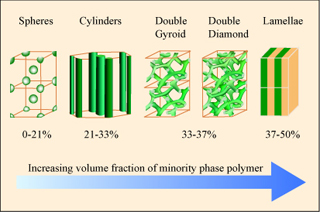
The various morphologies formed by self-assembling block copolymers can be used in a range of optical, magnetic, and electronic applications. (Figure by MIT OpenCourseWare.)
Instructor(s)
Prof. Edwin (Ned) Thomas
MIT Course Number
3.063
As Taught In
Spring 2007
Level
Undergraduate
Course Description
Course Features
Course Description
This course presents the mechanical, optical, and transport properties of polymers with respect to the underlying physics and physical chemistry of polymers in melt, solution, and solid state. Topics include conformation and molecular dimensions of polymer chains in solutions, melts, blends, and block copolymers; an examination of the structure of glassy, crystalline, and rubbery elastic states of polymers; thermodynamics of polymer solutions, blends, crystallization; liquid crystallinity, microphase separation, and self-assembled organic-inorganic nanocomposites. Case studies include relationships between structure and function in technologically important polymeric systems.


